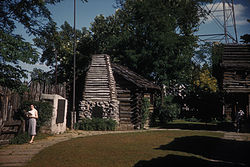Fort Nashborough
|
Fort Nashborough
|
|
|
Formerly listed on the U.S. National Register of Historic Places
|
|

Reconstructed replica of Fort Nashborough
|
|
| Location | Riverfront Park on 1st Ave. Nashville, Tennessee |
|---|---|
| Coordinates | 36°9′51″N 86°46′28″W / 36.16417°N 86.77444°WCoordinates: 36°9′51″N 86°46′28″W / 36.16417°N 86.77444°W |
| Architect | North Carolina Militia (Overmountain Men) |
| Architectural style | log stockade |
| NRHP Reference # | 11000454 |
| Significant dates | |
| Added to NRHP | July 13, 2011 |
| Removed from NRHP | November 24, 2015 |
Fort Nashborough was the established in early 1779 in the French Lick area of the Cumberland River valley, as a forerunner to the settlement that would become the city of Nashville, Tennessee. The log was square in shape and covered 2 acres (8,100 m2). It contained 20 log cabins and was protection for the settlers against wild animals and Indians. Today, a reconstructed fortification, maintained by Nashville Parks and Recreation, stands near the site of the original structure.
The American Revolution broke out one month after Richard Henderson's purchase agreement with the Cherokee for the lands of the proposed Transylvania settlement was signed.
Most Cherokee towns wished to stay neutral in the growing contest between the colonists and Britain, but Chief Dragging Canoe considered the war an opportunity to resist the continual encroachment by frontiersmen on traditional Cherokee territories. American retaliatory raids against his Cherokee towns in eastern Tennessee eventually forced Dragging Canoe to move his people farther to the south and west –down the Tennessee River. In 1779 they settled along Chickamauga Creek (near present-day Chattanooga, Tennessee), becoming known as the Chickamauga Cherokees. Later they were forced to move even further west and southwest, where they established the "Five Lower Towns", and were often thereafter referred to as the "Lower Cherokee". Dragging Canoe had promised to make any white settlers pay a "heavy price" if they moved into the Cumberland River valley, and he was to make good his word.
No attempt had previously been made to permanently settle the area then known only as French Lick along the banks of the Cumberland River. In 1779, John Buchanan Sr. migrated with his family from Cumberland County, Pennsylvania, to North Carolina. He first went to the "over-mountain" area of Virginia (modern day eastern Kentucky) in order to leave the party's women and small children in a secure area. The settlers then headed down the Cumberland River and, in early 1779, built a fortified station at French Lick (later to be called Fort Nashborough).
...
Wikipedia


